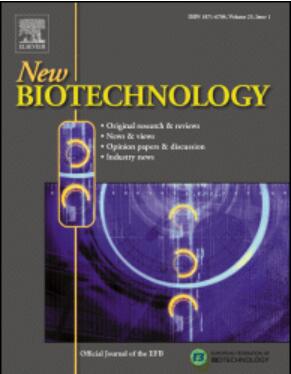IF 4.5
2区 生物学
Q1 BIOCHEMICAL RESEARCH METHODS
引用次数: 0
摘要
微藻是一种前景广阔的绿色能源。它们能生产蛋白质和脂质等有价值的生物产品,并能清除大气中的碳。在这项研究中,我们开发了一种微流控芯片,用于培养和筛选蛋白质和脂质含量高的微藻。30 多种微藻培养物可在芯片上的悬挂液滴中平行生长,并分别接受各种实验处理,如随机突变或不同的光照水平。微流控芯片设计简单,由光学透明的聚甲基丙烯酸甲酯制成,无需复杂设备(如注射泵)即可轻松操作。通过培养蓝藻,并在不同紫外线和照明处理后对其蛋白质含量进行原位荧光素测量,对该设计进行了实验验证;观察到所选突变体的蛋白质产量显著增加(约 36%),并在优化照明(2500 勒克斯;约 35%)后进一步增加。此外,利用生物相容性琼脂糖凝胶分别固定悬滴培养的红球菌,可进行原位拉曼光谱测量,从而快速确定脂质成分。我们开发的单滴拉曼光谱方法不仅能量化脂质含量,还能揭示其详细的化学成分。总之,所设计的微流控芯片适用于原位荧光检测和拉曼光谱,是高通量筛选藻类脂质和蛋白质的理想解决方案,可减少培育突变藻类和优化藻类培养所需的劳动力。本文章由计算机程序翻译,如有差异,请以英文原文为准。
Microfluidic method for rapidly determining the protein and lipid yield of microalgae
Microalgae are a promising source of green energy. They produce valuable bioproducts, such as proteins and lipids, and remove atmospheric carbon. In this study, we developed a microfluidic chip for culturing and screening for microalgae with high protein and lipid contents. Over 30 microalgae cultures can be grown in parallel in hanging drops on the chip and separately subjected to various experimental treatments, such as random mutations or different light levels. The microfluidic chip has a simple design and was fabricated from optically transparent polymethyl methacrylate; it could be easily operated without complex equipment (e.g., a syringe pump). The design was experimentally validated by culturing Cyanidium sp. and performing in-situ fluorescein measurements of its protein content after various ultraviolet and illumination treatments; significant increases in protein yield were observed for selected mutants (approximately 36 %) and further increased with optimized illumination (2500 lux; approximately 35 %). Moreover, Botryococcus braunii cultured in hanging drops that were separately immobilized using a biocompatible agarose gel for in-situ Raman spectroscopy measurements that rapidly determined the lipid composition. Our developed single-drop Raman spectroscopy method not only quantified the lipid content but also revealed its detailed chemical composition. In summary, the designed microfluidic chip is suitable for in-situ fluorescent assays and Raman microspectroscopy and is a compelling solution for high-throughput screening of algal lipids and proteins, reducing the labor required for breeding mutant algae and optimizing algal cultivation.
求助全文
通过发布文献求助,成功后即可免费获取论文全文。
去求助
来源期刊

New biotechnology
生物-生化研究方法
CiteScore
11.40
自引率
1.90%
发文量
77
审稿时长
1 months
期刊介绍:
New Biotechnology is the official journal of the European Federation of Biotechnology (EFB) and is published bimonthly. It covers both the science of biotechnology and its surrounding political, business and financial milieu. The journal publishes peer-reviewed basic research papers, authoritative reviews, feature articles and opinions in all areas of biotechnology. It reflects the full diversity of current biotechnology science, particularly those advances in research and practice that open opportunities for exploitation of knowledge, commercially or otherwise, together with news, discussion and comment on broader issues of general interest and concern. The outlook is fully international.
The scope of the journal includes the research, industrial and commercial aspects of biotechnology, in areas such as: Healthcare and Pharmaceuticals; Food and Agriculture; Biofuels; Genetic Engineering and Molecular Biology; Genomics and Synthetic Biology; Nanotechnology; Environment and Biodiversity; Biocatalysis; Bioremediation; Process engineering.
 求助内容:
求助内容: 应助结果提醒方式:
应助结果提醒方式:


